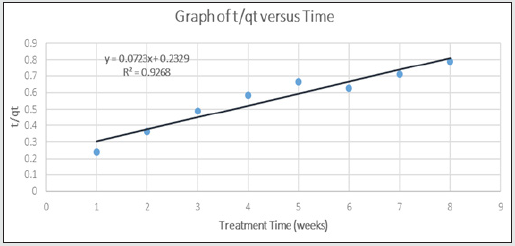
Lupine Publishers Group
Lupine Publishers
Menu
Research Article(ISSN: 2641-6875) 
Bioremediation of Used Engine Oil Polluted Soil Using Goat Manure Volume 2 - Issue 3
Onaiwu, DO1 and Ilaboya IR2*
- 1Department of Petroleum Engineering, Faculty of Engineering, University of Benin, Benin City, Edo State, Nigeria
- 2Department of Civil Engineering, Faculty of Engineering, University of Benin, Benin City, Edo State, Nigeria
Received:August 16, 2021; Published:September 13, 2021
*Corresponding author:Ilaboya IR, Department of Civil Engineering, Faculty of Engineering, University of Benin, Benin City, Edo State, Nigeria
DOI: 10.32474/CTBM.2021.02.000137
Abstract
Hydrocarbon contamination of land, water, air, vegetation and human is a widespread global environmental concern. The aim of this study was to evaluate the performance of goat manure for the bioremediation of used engine oil polluted soil. 10kg soil sample was collected from a site free of used engine oil contamination (from an agricultural land in The Department of Petroleum Engineering, Faculty of Engineering, University of Benin, Ugbowo Campus, Benin City, Edo State in Nigeria) using a 22-cm hand-dug soil auger and stored in labeled black polythene bag. The sample was air dried, grinded and sieved through 2mm mesh before use. Before contamination, the soil sample was subjected to chemical digestion using 1:1 ratio of 0.25M hydrochloric acid and Nitric acid. Thereafter it was characterized to determine the physio-chemical properties. The physio-chemical properties determined include Total Heterotrophic bacterial, Moisture content Soil, pH, Electrical conductivity, Total hydrocarbon content (THC), Total organic carbon, Total nitrogen content in addition to the soil composition including percent sand, Total Phosphorus, Lead (Pb) and Iron (Fe). The used engine oil was added gradually into the bowl containing the unpolluted sieved soil sample and was properly mixed.
The used engine oil was to serve as the pollutant. The soil samples were left for 4days for stabilization before the commencement of treatment process. The experiment was monitored for a period of eight (8) weeks under which appreciable level of remediation had been obtained. Result obtained shows that there was a gradual increase in pH, Electrical conductivity (EC) and Total Heterotrophic bacterial (THB), and also a gradual decrease in total nitrogen content (TNC), total organic carbon (TOC), total phosphorus (TP), lead (Pb), Iron (Fe) and total hydrocarbon content (THC). The result explicitly showed that goat manure is a good substrate for bioremediation of used engine oil polluted site with calculated engine oil removal efficiency of 62.67%. The kinetic modelling shows that the experimental data fitted well with pseudo-second order kinetic model. On predicting the rate of hydrocarbon loss with time the non-linear regression model gave higher coefficient of determination of 0.9874 compared to the linear regression model that gave 0.9665.
Keywords: Bioremediation; Used engine oil; Pollution; Goat manure; Linear; Non-Linear Regression
Introduction
Bioremediation is the technique which involves the productive use of the bio-degradative process for the elimination or detoxification of pollutants from the environment. It is a process to treat contaminated media, including water, soil and subsurface material, by altering environmental conditions to stimulate growth of micro-organisms and degrade the target pollutant [1]. Bioremediation is an evolving method for the removal and degradation of many environmental pollutants including the products of petroleum industry [2]. Generally, bioremediation technologies can be classified as in situ or ex situ. In situ bioremediation involves treating the contaminated material at the site while ex situ involves the removal of the contaminated material to be treated elsewhere [3]. Different techniques are employed depending on the degree of saturation and aeration of an area. In situ techniques are defined as those that are applied to soil and groundwater at the site with minimal disturbance. Ex situ techniques are those that are applied to soil and groundwater at the site which has been removed from the site via excavation for soil or pumping for water [4]. It mainly involved bio-stimulation where organic or inorganic components were introduced to enhance indigenous microbial growth that directly degrades the contaminants. Environmental degradation is the deterioration of the environment through depletion of resources such as air, water, and soil the destruction of ecosystems; habitat destruction; the extinction of wildlife; and pollution [5]. Environmental degradation is occasioned by consistent flow of industrial waste, oil spills, gas flares, fire disasters, acid rain, etc., which has led to the pollution of farmlands and fishponds. It has also led to the destruction of properties and human life, including aquatic and biodiversity [6].
Used engine oil and fuel spills in soil are among the most extensive and environmentally damaging pollution problems as it is threatening to human health and eco-systems. There are three methods involved in the remediation of sites contaminated due to hydrocarbon [7,8] Phytoremediation, Bioremediation and Chemical remediation. In this work, the method that is adopted is the Bioremediation method because it uses nature to fix nature. some advantages of these method are: Completely natural process with almost no harmful side effects, carried out in situ for most applications with no dangerous transport, cost effective to maintain and economical to input, little energy consumed compared to incineration and landfilling and High acceptance from regulatory authorities, etc. Used Engine oil contaminated soil causes organic pollution of underground water which restrict it use and causes economic loss, environmental problems and decreases the agricultural productivity of the soil. It could reduce or stop plant growth leading to death as a result of forming a physical barrier and coating the roots [9]. Reducing the petroleum hydrocarbon compounds in a polluted environment becomes a significant challenge for oil. companies are forced to conduct an adequate and effective treatment of these pollutant emissions. Thermal treatment, soil washing, soil vapor extraction, solidification, and stabilization are physical and chemical techniques used to treat petroleum hydrocarbon-polluted soil. However, they are often expensive, ineffective, and rarely neutral. Bioremediation of hydrocarbons in polluted soils is a promising treatment method. Based on the principle of complete mineralization or transformation of petroleum products into less toxic forms by different groups of microorganisms, bioremediation is the most effective, non-invasive, the least expensive and eco-friendly technique.
Experimental Procedures
The procedures adopted by [10] was employed with slight modifications as follows; 10kg soil sample was collected from a site free of used engine oil contamination (from an agricultural land in The Department of Petroleum Engineering, Faculty of Engineering, University of Benin, Ugbowo campus, Benin City, Edo State in Nigeria) using a 22-cm hand-dug soil auger and stored in labeled black polythene bag. The sample was air dried, grinded and sieved through 2mm mesh before use [11]. Before contamination, the soil sample was subjected to chemical digestion using 1:1 ratio of 0.25M hydrochloric acid and Nitric acid. Thereafter it was characterized to determine the physio-chemical properties [12]. The physiochemical properties determined include Total Heterotrophic bacterial, Moisture content Soil, pH, Electrical conductivity, Total hydrocarbon content (THC), Total organic carbon, Total nitrogen content in addition to the soil composition including percent sand, Total Phosphorus, Lead (Pb) and Iron (Fe). 10kg of unpolluted soil was weighed into a plastic bowl in addition to 2.5kg of concentrated used engine oil [13]. The used engine oil was added gradually into the bowl containing the unpolluted sieved soil sample and was properly mixed. The used engine oil was to serve as the pollutant. The moisture content of the used engine oil contaminated soil sample was determined immediately after adequate mixing. The soil samples were left for 4days for stabilization before the commencement of treatment process. After contamination, the used engine oil polluted soil sample was again subjected to chemical digestion using 1:1 ratio of 0.25M hydrochloric acid and Nitric acid. Thereafter, the polluted soil was characterized to determine the physio-chemical properties . For effective treatment, a 2:1 mixture (w/w) of the polluted soil and the substrate in addition to 25ml of nutrient agar was utilized.
The experiment was monitored for a period of eight (8) weeks under which appreciable level of remediation had been obtained. Samples were collected for analysis on weekly basis with the sample mean and standard deviation of the parameters computed to ascertain the rate of used engine oil degradation with treatment time. The amount of petroleum hydrocarbon removed during the series of batch investigation was determined using the mass balance equation of the form [14]:

Where: q, defines the petroleum hydrocarbon uptake (mg/g); C0 and Ce: are the initial and equilibrium petroleum hydrocarbon concentrations in the digested soil solution [mg/l] respectively; V: is the weight of soil sample taken (g) and M: is the mass of substrate used (g).
The efficiency of petroleum hydrocarbon removal (%) was calculated using the mass balance equation of the form [15].

Where: C0 and Ce are total hydrocarbon content (THC) (mg/l) in digested soil solution before and after treatment respectively.
To study the kinetics of used engine oil degradation, the following models were applied, namely: Pseudo-first order kinetic model and Pseudo-second order kinetic model.
The pseudo first-order rate expression of Lagergren based on the solid capacity is generally expressed as follows:

Where:
qe and qt are the amount of engine oil removed at equilibrium and at time t, respectively (mg·g-1), K1is the rate constant of pseudo first-order adsorption (Lagergren and Svenska, 1998). The linear plots of Log [qe – qt] versus time (t) show the appropriateness of the above equation and subsequently the first order nature of the process involved [16].
The pseudo-second- order equation is also based on the sorption capacity of the solid phase.

The plot of (t/qt ) against (t) should give a linear relationship from which qe and K2 can be determined from the slope and intercept of the plot [17-22].
Results and Discussion
The physio-chemical properties of the experimental soil used for investigation is presented in Table 1
Results of Table 1 shows that the experimental soil is alkaline in nature with a pH of 8.4, and with a moisture content of 0.54 percent and fertile with total organic carbon, total nitrogen, and total Phosphorous of 6.82g/kg, 7.33g/kg, and 6.75g/kg respectively. The soil electrical conductivity which is also an important indicator of soil health was measured to be 43.27μs/cm. It was also discovered from the physio-chemical analysis that the soil was completely free from crude petroleum hydrocarbon pollution as evident from the result of the total hydrocarbon content. The iron content and the total heterotrophic bacterial was also gotten to be 1.74mg/kg and 7.6*105. The physio-chemical properties of the used engine oil polluted soil that was employed for this study is presented in Table 2. The addition of used engine oil to the experimental soil resulted in the contamination of the soil which altered the physio-chemical properties of the soil. The results of changes in the soil physiochemical properties occasioned by the addition of used engine oil are presented as follows
a. The pH value of the soil decrease from 8.4 to 2.89 and this shows that the presence of the used engine oil made the soil to become highly acidic and this will result in poor plant growth or no growth at all around the area of contamination.
b. The high level of electrical conductivity (from 43.27 μs/cm to 79.93 μs/cm) occasioned by the presence of high concentration of dissolved solids as seen from the results of conductivity, this higher electrical conductivity hinders the nutrient uptake by increasing the osmotic pressure of the nutrient solution, wastes nutrients, and increases discharged of nutrients into the environment, resulting in environmental pollution.
c. A drastic reduction in total nitrogen, total phosphorus and total organic carbon concentration occasioned by a sudden increase in the hydrocarbon content of the soil due to contamination.
d. It was also observed from the result that the addition of used engine oil to the soil resulted in a drastic reduction in the total heterotrophic bacterial count from 7.6x105cfu/g to 2.16x105cfu/g due to contamination.
e. There was also a slight decrease in Iron (Fe) and a slight increase in Lead (Pb)
Effects of Remediation on pH
The effects of substrate addition (Bioremediation) on the total pH of used engine oil contaminated soil was studied for a period of 8 weeks and result obtained in graphical plot is presented in (Figure 1). It can be deduced that the pH of the soil increases upon treatment, the graph depicts a gradual increase in ph. [23] carried out a similar study using fish waste and goat manure, it was observed from the experimental results that; there was a gradual increase in the pH of the soil over a period of 7 to 56 days of treatment, and this aligns with the result gotten from this experiment. also had a similar result, that is an increase in pH due to treatment which lasted for 4 weeks. Extremes pH of soils would have a negative influence on the ability of microbial populations to degrade hydrocarbons.
Effects of Remediation on Total Nitrogen Content (TNC)
The effects of substrate addition (Bioremediation) on the total nitrogen content was studied for period of 8 weeks and result obtained is presented in (Figure 2). The gradual decrease in the total nitrogen content with increase in remediation time could be traced to the increase in the population of total heterotrophic bacterial count occasioned by nutrient utilization. Heterotrophic bacterial normally utilized the available nutrient in the form of total nitrogen, total organic carbon and total phosphorous for their growth and cell development; consequently, leading to a drastic reduction in the nutrient level. carried out an enhanced bioremediation of soil artificially contaminated with petroleum hydrocarbons using goat manure, the result obtained from that experiment correlate with the results gotten from this experiment.
Effects of Remediation on Total Phosphorus Content (TPC)
The effects of substrate addition (Bioremediation) on the total phosphorous content was studied for a period of 8 weeks and result obtained is presented in (Figure 3). From the above graph it can be said that there is a gradual decrease in phosphorous which may be attributed to the increase in the population of total heterotrophic bacterial count occasioned by nutrient utilization. Heterotrophic bacterial normally utilized the available nutrient in the form of total nitrogen, total organic carbon and total phosphorous for their growth and cell development.
Effects of Remediation on Total Hydrocarbon Content (THC)
The effects of substrate addition (Bioremediation) on the total hydrocarbon content of used engine oil contaminated soil was studied for a period of 8 weeks and result obtained is presented in (Figure 4). From the graph, the degradation rate of the total hydrocarbon content with respect to the substrate used from week one to week five shows a constant degradation rate but with week five and week six there was a change, a rapid increase in degradation which may be as a result of the microorganisms stabilizing and became well adapted to the environment, they tend to grow and developed based on the available nutrient while also eating up the hydrocarbon thus bringing about possible cleanup. The result gotten by [23] revealed a decrease in total hydrocarbon content and this aligns with this experimental result.
Effects of Remediation on Total Heterotrophic Bacterial (THB)
The effects of substrate addition (Bioremediation) on the total heterotrophic bacterial growth was studied for a period of 8 weeks and result obtained is presented in (Figure 5). (Figure 6,7) revealed a continuous increase in the population of hydrocarbon utilizing microorganisms especially with the addition of treatment substrates, hence the higher reduction in residual used engine oil observed throughout the period of experimentation. observed an increase in the total heterotrophic bacterial with time and this resulted in a corresponding removal of hydrocarbon and thus this agrees with the inference drawn from the present findings. Stanley (2013) observed an increase in the total heterotrophic bacterial in his studies.
Effects of Treatment on Total Organic Carbon (TOC)
The trend that applies to total nitrogen content due to substrate addition also applies to total organic carbon since the nutrient level of soil is measured based on the concentration of total nitrogen, total organic carbon and total phosphorous content. The gradual decrease in the total organic carbon with increase in remediation time could be traced to the increase in the population of total heterotrophic bacterial count occasioned by nutrient utilization. This reduction can also be attributed to the steady and continuous consumption of this nutrient by the microorganism for growth and development [24].
Efficiency of Removal
It can be deduced from the result of (Figures 8,9) that, the amount of used engine oil removed increases with Treatment time. Increase in the amount of total hydrocarbon content removed and efficiency of remediation with treatment time can be traced to the increase in the population of the heterotrophic bacteria resulting from the gradual depletion in the available nutrients such as total organic carbon and total nitrogen.
Kinetics of Bioremediation
The kinetic model was employed to study how the remediation process depends on time. In order to study the kinetics of bioremediation, the data gotten from the experiment were fitted into the first and second order kinetic model. The main focus was to monitor the change in the concentration of hydrocarbon with treatment time in other to understand the nature of chemical reaction involved in the biodegradation of used engine oil. Results of the kinetic studies is presented in (Figures 10,11) respectively. The kinetic modelling shows that the experimental data fitted well with pseudo-second order kinetic model. Hence, it was concluded that the bioremediation of crude oil polluted soil is a reactioncontrolled process in which the reaction dynamics is purely define by chemisorption.
Figure 10: Pseudo-Second order kinetic model for the bioremediation of used engine oil polluted soil.

Predicting the Efficiency of Remediation using Linear and Non-linear Regression
To determine the mathematical relationship between efficiency of used engine oil degradation and remediation time, Linear and Non-linear regression modelling was done. To select the model that best explain this relationship, coefficient of determination (R2) which measures the corresponding change in the dependent variable occasioned by change in independent variable was employed. The result of Linear and Non-Linear regression is presented in (Figures 12) respectively. From the result of (Figure 12), it was observed that the coefficient of linear determination (the R squared value) is 0.9665 representing 96.65% reliability. The mathematical relationship between the remediation time and used engine oil removal efficiency for goat manure as the substrate was developed as follows Efficiency of Removal (%) = 21.478 + 5.4901(Remediation Time) In terms of the coded variable; Y = 21.478 + 5.4901X Where Y is the removal efficiency and X is the remediation time From the result of, it was observed that the coefficient of linear determination (the R squared value) is 0.9874 representing 98.74% reliability. Based on the higher (R2) value of the non-linear regression analysis compared to the linear regression analysis, prediction of the efficiency of removal with projected values of remediation time was done using the quadratic polynomial (Fourth degree polynomials). The mathematical relationship between the remediation time and used engine oil removal efficiency for goat manure as the substrate was developed as follows;
Efficiency of Removal (%) = 6.342 + 27.807x – 10.121x2 + 1.7638x3 – 0.103x4
In terms of the coded variable; Y = 6.342 + 27.807x – 10.121x2 + 1.7638x3 – 0.103x4
Where Y= Dependent variable (removal efficiency %), x = Independent variable (Treatment time)
Conclusion
Bioremediation is a treatment that uses naturally occurring organism to break down hazardous substance into less toxic or nontoxic substance. From the experimental results obtained coupled with the analysis of the experimental data sets, it could be seen that goat manure is an effective substrate for the biodegradation of used engine oil polluted soil since they can facilitate the rate of breakdown of the hydrocarbon component of the used engine oil. The extent of remediation was judged based on change in the concentration of some selected parameters with time. The selected parameters include pH, electrical conductivity, total organic carbon, total nitrogen, total phosphorus, lead (Pb), Iron (Fe), total heterotrophic bacterial and the total hydrocarbon content. Based on the research studies, the following conclusion were drawn.
a. It was observed that for the entire period of experimentation (8 weeks), there occur a gradual increase in pH, Electrical conductivity and Total Heterotrophic bacterial.
b. It was also observed that for the entire period of experimentation (8 weeks), there occur a gradual decrease in the total nitrogen content (TNC), total organic carbon (TOC), total phosphorus (TP), Lead (Pb), Iron (Fe) and total hydrocarbon content (THC).
c. As the microorganism utilizes the available nitrogen, phosphorus and organic carbon present in the soil and increase in population, they again react with and break down the agent that causes the pollution which is the used engine oil.
d. The second order kinetic model was observed to have a better fitting of the experimental data sets.
e. The non-linear regression model performs better than the linear regression model in predicting the rate of hydrocarbon loss with time for the substrate and was applied to predict the efficiency of used engine oil degradation as a function of remediation time.
References
- “Green Remediation Best Management Practices: Sites with Leaking Underground Storage Tank Systems. EPA 542-F-11-008” EPA.
- Medina Bellver JI, Marín P, Delgado A, Rodríguez Sánchez A, at al (2005) Evidence for in situ crude oil biodegradation after the Prestige oil spill, Environ. Microbiol 7(6): 773-779.
- Gavrilescu M (2010) Environmental Biotechnology: Achievements Opportunities and Challenges Dynamic Biochemistry Process Biotechnology and Molecular Biology 4(1): 1-36.
- Vidali M (2001) Bioremediation: An overview Pure and Applied Chemistry 73(7): 1163 -1172.
- Johnson DL, Ambrose SH, Bassett TJ, Bowen ML, Crummey DE, at al (1997) Meanings of environmental terms. Journal of Environmental Quality 26(3): 581-589.
- Ugboma PP (2015) Environmental Degradation in Oil Producing Areas of Niger Delta Region, Nigeria. In: Romero-Zerón L, editor. Introduction to Enhanced oil on Recovery (EOR) processes and Bioremediation of oil contaminated sites. China: Intech publisher :186-206.
- Abha S Singh CS (2012) Hydrocarbon pollution: Effects on living organisms remediation of contaminated environment and effects of heavy metals co-concentration on bioremediation Global NEST Journal 15(4): 474-484.
- Dave D, Ghaly AE (2011) Remediation technologies for marine oil spills A critical review and comparative analysis. American Journal of Environmental Sciences 7(5): 423-440.
- Fowzia A, Fakhruddin ANM (2018) A Review on Environmental contamination of petroleum hydrocarbon and its Biodegradation. International Journal of Environmental Science and Natural Resources 11(3): 555-811.
- Isitekhale HHE, Aboh S, Edion RI, Abhanzioya MI (2013) Remediation of Crude Oil Contaminated Soil with Inorganic and Organic Fertilizer Using Sweet Potato as a Test Crop, Journal of Environment and Earth Science 3(7): 116-121.
- Agamuthu P, Dadrasnia A (2013) Potential of bio-waste’s to remediate diesel, fuel contaminated soil, Global NEST Journal 15(4): 474-484.
- Ayotamuno MJ, Kogbara RB, Ogaji SOT, Prober SD (2006) Bioremediation of a crude-oil polluted agricultural-soil at Port Harcourt, Nigeria, Applied Energy 83(11): 1249-1257.
- Agarry SE, Owabor CN, Yusuf RO (2010) Bioremediation of Soil Artificially Contaminated with Petroleum Hydrocarbon Oil Mixtures: Evaluation of the Use of Animal Manure and Chemical Fertilizer, Bioremediation Journal 14(4): 189-195.
- Raghuvanshi SP, Singh R Kaushik CP (2004) Kinetics studies of Methylene blue dye bio-adsorption on Bagasse, Applied Ecology and Environmental Research journal 2(2): 35 -43.
- Eba F, Gueu S, Eya A, Mvongbote A, Ondo JA, et al (2010) Evaluation of the adsorption capacity of the natural clay from Bikougou (Gabon) to remove manganese (II) from aqueous solution. International Journal of Engineering science and technology 2(10): 5001-5016.
- Lagergren S, Svenska BK (1998) Zur theorie der sogenannten adsorption geloester stoffe. Veternskapsakad Handlingar 24(4): 1-39.
- HO YS McKay G (1999) The kinetics of sorption of divalent metal ions onto sphagnum moss peat Water Resource Journal 34(3): 735-742.
- Nwogu TP, Azubuike CC, Ogugbue CJ (2015) Enhanced Bioremediation of Soil Artificially Contaminated with Petroleum Hydrocarbons after Amendment with capra aegagrus hircus (Goat) Manure. Biotechnology Research International, Volume 2015 Article ID 657349:1-7.
- Ogoanah SO (2020) Enhancement of the soil quality of an oil polluted ultisol using livestock wastes. Notulae Scientia Biologicae 12(2): 387-398.
- Shamik C, Papita S, (2010) Pseudo-second-order kinetic model for sorption of malachite green onto sea shells comparison of linear and non-linear methods the IIOAB Journals (Research Bio-Physics) 1(3): 3-7.
- Onuoha SC (2013) Stimulated Biodegradation of Spent Lubricating Motor oil in Soil Amended with Animal droppings. Journal of natural science research 3(12): 33-45.
- Yuh-Shan HO, (2006) Review of second-order models for adsorption systems, Journal of Hazardous materials, vol. B 136(3): 681-689.
- Awari VG, Ogbonna DN, Nrior RR (2020) Bio-stimulation approach in bioremediation of crude oil contaminated soil using fish waste and goat manure. Microbiology research journal international 30(1): 33-46.
- ‘’EPA enforcement targets flaring efficiency violations’’ (PDF) US Environmental Protection Agency 2012-08-01. Retreived 2020-02-08.

Top Editors
-

Mark E Smith
Bio chemistry
University of Texas Medical Branch, USA -

Lawrence A Presley
Department of Criminal Justice
Liberty University, USA -

Thomas W Miller
Department of Psychiatry
University of Kentucky, USA -

Gjumrakch Aliev
Department of Medicine
Gally International Biomedical Research & Consulting LLC, USA -

Christopher Bryant
Department of Urbanisation and Agricultural
Montreal university, USA -

Robert William Frare
Oral & Maxillofacial Pathology
New York University, USA -

Rudolph Modesto Navari
Gastroenterology and Hepatology
University of Alabama, UK -

Andrew Hague
Department of Medicine
Universities of Bradford, UK -

George Gregory Buttigieg
Maltese College of Obstetrics and Gynaecology, Europe -

Chen-Hsiung Yeh
Oncology
Circulogene Theranostics, England -
.png)
Emilio Bucio-Carrillo
Radiation Chemistry
National University of Mexico, USA -
.jpg)
Casey J Grenier
Analytical Chemistry
Wentworth Institute of Technology, USA -
Hany Atalah
Minimally Invasive Surgery
Mercer University school of Medicine, USA -

Abu-Hussein Muhamad
Pediatric Dentistry
University of Athens , Greece

The annual scholar awards from Lupine Publishers honor a selected number Read More...


















